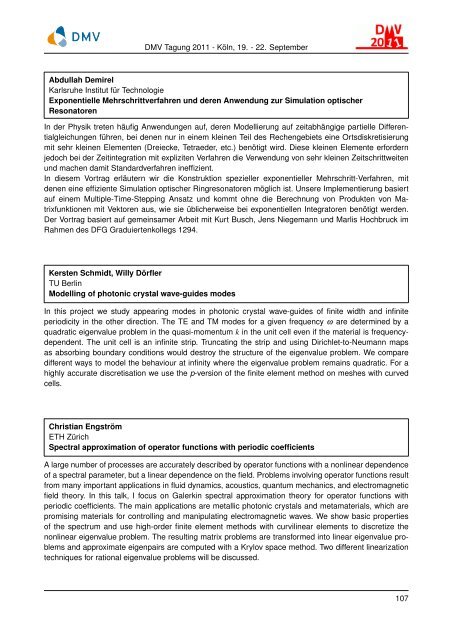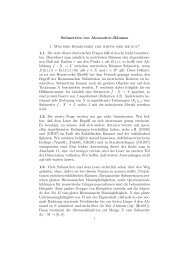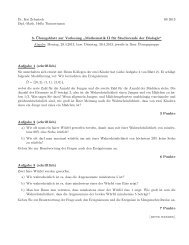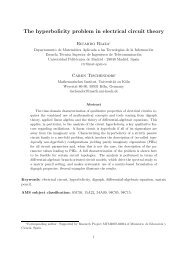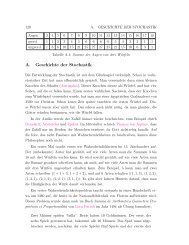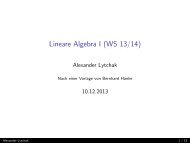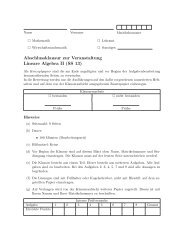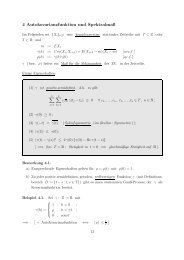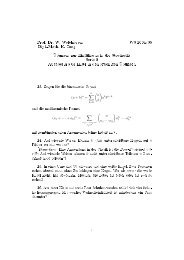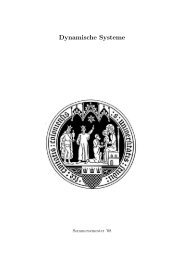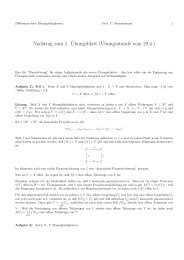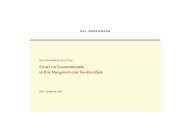Inhaltsverzeichnis - Mathematisches Institut der Universität zu Köln
Inhaltsverzeichnis - Mathematisches Institut der Universität zu Köln
Inhaltsverzeichnis - Mathematisches Institut der Universität zu Köln
You also want an ePaper? Increase the reach of your titles
YUMPU automatically turns print PDFs into web optimized ePapers that Google loves.
DMV Tagung 2011 - <strong>Köln</strong>, 19. - 22. September<br />
Abdullah Demirel<br />
Karlsruhe <strong>Institut</strong> für Technologie<br />
Exponentielle Mehrschrittverfahren und <strong>der</strong>en Anwendung <strong>zu</strong>r Simulation optischer<br />
Resonatoren<br />
In <strong>der</strong> Physik treten häufig Anwendungen auf, <strong>der</strong>en Modellierung auf zeitabhängige partielle Differentialgleichungen<br />
führen, bei denen nur in einem kleinen Teil des Rechengebiets eine Ortsdiskretisierung<br />
mit sehr kleinen Elementen (Dreiecke, Tetrae<strong>der</strong>, etc.) benötigt wird. Diese kleinen Elemente erfor<strong>der</strong>n<br />
jedoch bei <strong>der</strong> Zeitintegration mit expliziten Verfahren die Verwendung von sehr kleinen Zeitschrittweiten<br />
und machen damit Standardverfahren ineffizient.<br />
In diesem Vortrag erläutern wir die Konstruktion spezieller exponentieller Mehrschritt-Verfahren, mit<br />
denen eine effiziente Simulation optischer Ringresonatoren möglich ist. Unsere Implementierung basiert<br />
auf einem Multiple-Time-Stepping Ansatz und kommt ohne die Berechnung von Produkten von Matrixfunktionen<br />
mit Vektoren aus, wie sie üblicherweise bei exponentiellen Integratoren benötigt werden.<br />
Der Vortrag basiert auf gemeinsamer Arbeit mit Kurt Busch, Jens Niegemann und Marlis Hochbruck im<br />
Rahmen des DFG Graduiertenkollegs 1294.<br />
Kersten Schmidt, Willy Dörfler<br />
TU Berlin<br />
Modelling of photonic crystal wave-guides modes<br />
In this project we study appearing modes in photonic crystal wave-guides of finite width and infinite<br />
periodicity in the other direction. The TE and TM modes for a given frequency ω are determined by a<br />
quadratic eigenvalue problem in the quasi-momentum k in the unit cell even if the material is frequencydependent.<br />
The unit cell is an infinite strip. Truncating the strip and using Dirichlet-to-Neumann maps<br />
as absorbing boundary conditions would destroy the structure of the eigenvalue problem. We compare<br />
different ways to model the behaviour at infinity where the eigenvalue problem remains quadratic. For a<br />
highly accurate discretisation we use the p-version of the finite element method on meshes with curved<br />
cells.<br />
Christian Engström<br />
ETH Zürich<br />
Spectral approximation of operator functions with periodic coefficients<br />
A large number of processes are accurately described by operator functions with a nonlinear dependence<br />
of a spectral parameter, but a linear dependence on the field. Problems involving operator functions result<br />
from many important applications in fluid dynamics, acoustics, quantum mechanics, and electromagnetic<br />
field theory. In this talk, I focus on Galerkin spectral approximation theory for operator functions with<br />
periodic coefficients. The main applications are metallic photonic crystals and metamaterials, which are<br />
promising materials for controlling and manipulating electromagnetic waves. We show basic properties<br />
of the spectrum and use high-or<strong>der</strong> finite element methods with curvilinear elements to discretize the<br />
nonlinear eigenvalue problem. The resulting matrix problems are transformed into linear eigenvalue problems<br />
and approximate eigenpairs are computed with a Krylov space method. Two different linearization<br />
techniques for rational eigenvalue problems will be discussed.<br />
107


